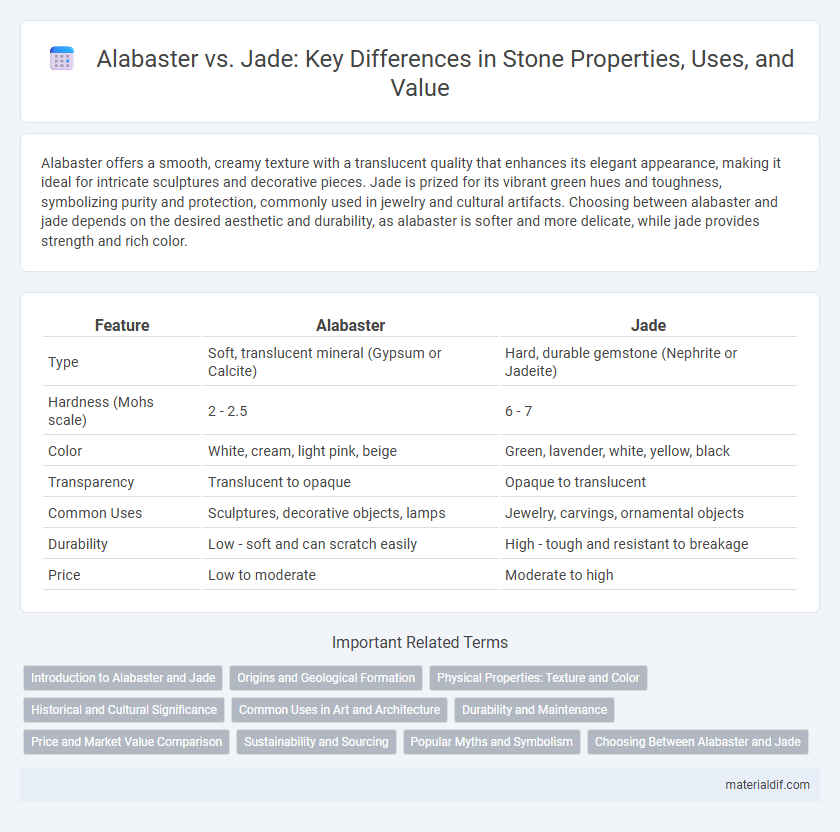Alabaster offers a smooth, creamy texture with a translucent quality that enhances its elegant appearance, making it ideal for intricate sculptures and decorative pieces. Jade is prized for its vibrant green hues and toughness, symbolizing purity and protection, commonly used in jewelry and cultural artifacts. Choosing between alabaster and jade depends on the desired aesthetic and durability, as alabaster is softer and more delicate, while jade provides strength and rich color.
Table of Comparison
| Feature | Alabaster | Jade |
|---|---|---|
| Type | Soft, translucent mineral (Gypsum or Calcite) | Hard, durable gemstone (Nephrite or Jadeite) |
| Hardness (Mohs scale) | 2 - 2.5 | 6 - 7 |
| Color | White, cream, light pink, beige | Green, lavender, white, yellow, black |
| Transparency | Translucent to opaque | Opaque to translucent |
| Common Uses | Sculptures, decorative objects, lamps | Jewelry, carvings, ornamental objects |
| Durability | Low - soft and can scratch easily | High - tough and resistant to breakage |
| Price | Low to moderate | Moderate to high |
Introduction to Alabaster and Jade
Alabaster is a soft, translucent stone primarily composed of gypsum or calcite, prized for its smooth texture and ease of carving, often used in decorative artifacts and sculptures. Jade, a tough and durable metamorphic rock, comes in two varieties--jadeite and nephrite--and is highly valued in jewelry and cultural art for its vibrant green hues and symbolic significance. Both stones have distinct physical properties and historical uses, making them important materials in art and craftsmanship.
Origins and Geological Formation
Alabaster is a fine-grained sedimentary rock primarily composed of gypsum or calcite, formed through the evaporation of ancient seas and typically found in arid regions like Italy and Egypt. Jade, on the other hand, is a metamorphic rock mainly consisting of either nephrite or jadeite, originating from high-pressure, low-temperature conditions in subduction zones and predominantly sourced from Myanmar, Guatemala, and Canada. The contrasting geological formations highlight alabaster's sedimentary evaporation process versus jade's complex metamorphic genesis.
Physical Properties: Texture and Color
Alabaster is a fine-grained, soft stone with a smooth, almost waxy texture, often appearing in creamy white or light shades of beige and pink. Jade, on the other hand, is a hard, dense stone with a smooth, polished surface, typically exhibiting vibrant green hues but also found in white, lavender, and other colors. The contrasting textures and color ranges of alabaster and jade make them distinct choices for sculpture and ornamental use.
Historical and Cultural Significance
Alabaster has been historically prized for its soft, translucent qualities, widely used in ancient Egyptian and Mesopotamian sculpture and religious artifacts symbolizing purity and protection. Jade holds profound cultural significance in East Asia, especially China, where it represents virtue, immortality, and status, often carved into ceremonial objects and jewelry for thousands of years. Both stones embody distinct cultural identities, with alabaster rooted in Middle Eastern ritual art and jade revered as a spiritual emblem across Asian civilizations.
Common Uses in Art and Architecture
Alabaster is prized for its smooth texture and translucency, frequently carved into intricate sculptures, decorative panels, and ornamental vases in classical and Renaissance art. Jade, valued for its toughness and vibrant green hues, is extensively used in East Asian art for creating jewelry, ceremonial objects, and architectural accents like roof tiles and columns. Both stones serve as symbolic materials: alabaster often represents purity and light, while jade embodies durability and spiritual significance in cultural artifacts.
Durability and Maintenance
Alabaster, a soft and porous stone, requires gentle handling and regular sealing to prevent damage and staining, making it less durable than jade. Jade, known for its exceptional hardness and resistance to scratches and chips, demands minimal maintenance and can withstand heavy use in sculptures and jewelry. Choosing jade offers long-lasting durability with low upkeep, whereas alabaster is ideal for delicate indoor decorative pieces that need careful care.
Price and Market Value Comparison
Alabaster and jade differ significantly in price and market value, with jade commanding a considerably higher market due to its rarity and demand in jewelry and ornamental art, often valued from hundreds to thousands of dollars per carat. Alabaster, primarily used for sculpture and interior decor, is generally more affordable, with prices typically ranging from a few dollars to several hundred dollars per piece depending on size and quality. The jade market's strong cultural significance and gemstone status drive its premium pricing, while alabaster's widespread availability and softer composition contribute to its lower market value.
Sustainability and Sourcing
Alabaster, primarily quarried in regions like Italy and Egypt, often involves environmentally sensitive extraction methods that can impact local ecosystems due to its softness and susceptibility to erosion. Jade, sourced mainly from Myanmar and Guatemala, presents sustainability challenges related to opaque mining practices and significant social concerns, including labor rights and ecological damage. Sustainable sourcing of both stones demands stringent regulations, transparent supply chains, and ethical mining initiatives to minimize environmental harm and support community welfare.
Popular Myths and Symbolism
Alabaster often symbolizes purity and peace in various cultures, frequently associated with healing and spiritual protection, while Jade is revered for its connections to wisdom, prosperity, and longevity, especially in East Asian traditions. Popular myths depict alabaster as a stone that can absorb negative energy, whereas jade is believed to bring good luck and harmony to its wearer. These symbolic meanings influence their use in artistic carvings, rituals, and jewelry, highlighting distinct cultural values tied to each stone.
Choosing Between Alabaster and Jade
Choosing between alabaster and jade depends on your desired aesthetic and durability requirements; alabaster offers a soft, translucent appearance ideal for decorative carvings, while jade provides exceptional toughness and vibrant green hues suited for jewelry and ornamental pieces. Alabaster's softness makes it easier to carve but less resistant to scratches and weathering compared to the dense, hard structure of jade. Consider alabaster for indoor artistic projects and jade for long-lasting, high-value items that require both beauty and strength.
Alabaster vs Jade Infographic

 materialdif.com
materialdif.com